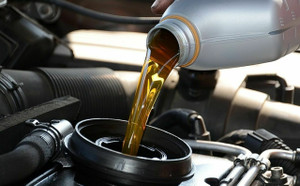How to change your oil
By Kijiji Autos
Changing a car’s oil is one, if not the most important maintenance staple. Not correctly changing your oil at the recommended intervals could lead to such disasters as sludge, seizing your engine, or worse. A lot of people would like to be able to do their own changes, but either never have the time or are too afraid to break something. But, there is nothing like changing your own oil to make you feel truly empowered! Okay, maybe empowerment isn’t the goal here, but with any luck, this guide should keep you on the straight path to oil success.
Things you’ll need:
- Your car’s owner’s manual
- A decent socket wrench set
- Oil pan for the old oil
- New oil and oil filter (in case this wasn’t obvious)
- Ramps or floor jack with jack stands
- Oil filter wrench (if necessary)
- A funnel
- Old rags
- Optional: disposable or mechanic-style gloves and protective eyewear are always recommended.
Why do you need your owner’s manual? Won’t this guide be enough? The answer is absolutely not. Every car is different in some way and you will need your owner’s manual to determine how much new oil you need to buy and what kind of oil filter to buy as well. Some manuals even contain their own oil change instructions. Make sure to get the right weight oil for your car as described in your manual. Do not use a different weight than recommended unless you really know what you’re doing. Head out to your favourite auto parts store and grab the consumables. Also recommended but not required on every oil change is to change the washer for the oil drain plug. Ask your auto parts store for help finding these and be sure to pick up a few for the future.
To start off, we want to get the old oil nice and warm so that it drains completely. Take the car for a five-minute drive or so and make sure the temperature gauge is in the normal driving range. Bring the car back to where you will be doing the work. This should preferably be on a flat surface and indoors if possible. Open up the oil filler cap on top of the engine and set it aside. I also like to remove the oil dipstick to allow for better flow when I remove the old oil.
Then, we need the car to be raised. Drive the car onto ramps or jack the car up from each side and place jack stands on either a major suspension component or structural part of the frame. Locate your oil drain plug. It is a smaller bolt usually at the bottom of a big tub hanging from the bottom of the engine, like the one pictured above. This is the car’s oil pan or reservoir. Place your collecting container underneath the drain plug. Find the appropriate socket size for the drain plug and begin to slowly loosen the plug. Stop using your ratchet to loosen the drain plug once it is free enough to loosen by hand. Slowly continue loosening it with your hand until oil starts to come out. Once a considerable amount has been drained, you can slowly remove the drain plug entirely, making sure not to drop it in your container.
Towards the end of the draining, locate and remove your oil filter. For some cars, this is easier said than done and might require a special tool called an oil filter wrench that hugs the oil filter in order to get it out. Be careful when taking it off as oil will probably fall out of it when you do. Dispose of the old filter.
Now that the draining is complete, wipe off the area around the drain hole, put on the new washer, and replace the drain plug, tightening with your ratchet only so that it is snug. Take your new oil filter, wipe off the mounting surface, and take some of the new oil onto your finger and apply some to the rim of the new oil filter. Screw the filter in by hand until it is snug; be careful not to over-tighten.
Now we can lower the car, which will be necessary if we want to add the appropriate amount of oil. Once lowered, take your funnel and put it in the oil filler hole. Take the appropriate amount of oil from the owners manual and add just a little bit less than that to start with. Replace the oil dipstick, remove it, wipe it, replace it again, remove it again, and check to see if the level is within the acceptable range. Add oil until it is. Make sure NOT to overfill the oil as you will have to lift the car and drain oil again. By this stage in the process, you will not want to do that.
Once you fell comfortable with the level, close everything up and start the engine. Look underneath the car and at the oil filter for any leaks. If everything checks out, go for a spin, and check the oil level again after the engine has sat for another ten minutes. And that’s it!
Please note that we are not responsible for any damage you may accidentally cause to your vehicle following these instructions. These instructions are meant as a very general guideline and further research on your specific vehicle is always recommended before attempting any of your own work.
Easily find your next ride on Kijiji Autos
Search nowCosts of Installing an Electric Car (EV) Charging Station in Canada
Installing a home EV charger can come with additional fees beyond purchase and installation. Here's a list of factors that can affect the price of a home EV charger.Toronto to Calgary Road Trip: Routes & Tips
Planning on driving from Toronto to Calgary? Here are some routes and tips to help you along the way.7 items you can fit in an SUV: TVs, mattresses and more
Discover seven common items that fit in an SUV below.Flat Tire vs Blowout: What's the Difference & What Should You Do?
The main difference between a flat tire and a blowout is that a blowout often feels like an explosion has occurred underneath your vehicle. Blowouts can cause sudden and drastic changes to the handling of your vehicle and can lead to minor or even serious accidents.Tips to help protect your vehicle and budget for car repairs
When shopping for your next vehicle, it's always a good idea to keep hidden costs in mind. Before you buy, let's look at how much it can cost to maintain a car in Canada, how much you could budget for annual maintenance and repairs, and how to help protect your car against damage and depreciationWhat is the value of undercoat protection on your vehicle?
When you buy a new vehicle, protecting it so that it lasts as long as possible is definitely top of mind, whether that's through security upgrades or an extra coat of paint. But how often do you consider the care and safety of your vehicle’s undercarriage?The top three best paint protection options for your vehicle
Buying a new vehicle is a great experience. Nothing beats hitting the road in a car you bought fresh off the lot. However, as fun as it is to finally get behind the wheel of your new ride, it's important to take your time through the process.Financial guide: post-pandemic car shopping and gas price hacks
With populations locked down and international borders closed the global supply chain has been disrupted on a massive scale, pushing up inflation around the world and raising the cost of everything that people need to get back to normal. Here are a few tips you can use to grab the vehicle you want without breaking the bank.10 tips to help make the road a better and happier place
We have all, at some point, been responsible for making the roadways stressful in one way or another. Alternatively, we are all equally capable of making the road a happier place. Let’s explore 10 unique ways we can help make the driving experience better again, for everyone's sake.10 eco-driving tips that can help you save money and reduce your carbon footprint
With rising gas prices, carbon taxes on fuel and concerns about climate change, many Canadians are wondering how to save gas when driving. Experts recommend adopting eco-driving techniques that can help you save money and fuel. Read on to discover 10 of them:








